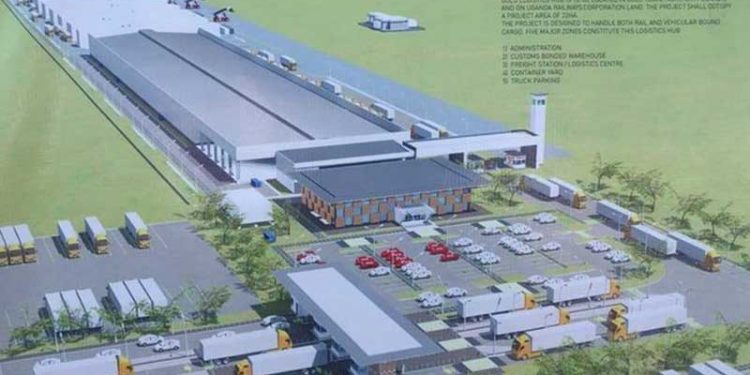The construction of Gulu Logistics Hub in Uganda is on schedule with 65 percent complete. This was revealed yesterday when the Uganda Revenue Authority (URA) toured the facility to assess its progress. The project is expected to be completed in September this year.
“On completion, this project will change several things. It will be the main import and export hub for this region, South Sudan and DRC. Gulu Logistics Hub will also lower the cost of doing business, create employment and benefit the local community,” John Musinguzi Rujoki, the URA Commissioner General said.
Uganda President Yoweri Museveni launched the ground-breaking of two flagship projects in October- the Gulu Logistics Hub, and rehabilitation of the Tororo-Gulu railway, in a move expected to stimulate trade in the region.
With the support of European Union (EU) and the UK’s Foreign and Commonwealth Development Office (FCDO), TradeMark East Africa (TMEA) together with the Ministry of Works and Transport and Uganda Railways Corporation, the projects begun in March 2020 and is expected to cost Euros 7.76M.
The Gulu Logistics Hub is expected to reduce barriers to trade for both Northern Uganda and the neighbouring countries of South Sudan and the Democratic Republic of Congo.
The Gulu Logistics Hub will serve the trade corridors of Kampala–Gulu–Elegu/Nimule–Juba Trade Corridor; and Gulu–Pakwach Goli/Pader/Lira/Vurra DRC Trade Corridor. The hub will handle over 500,000 containers at a time.
The hub lies on a 24.1 acres piece of land in Layibi division, Gulu Municipality and was given by the Uganda Railway Corporation (URC). It is located adjacent to the current Gulu railway station and connects to the major roads to South Sudan and Kampala.
The facility will handle containers, break-bulk, handling and storage facilities, space for stakeholders dealing with freight transport (freight forwarders, shippers and transport operators) and the provision of accompanying services such as customs inspections, tax payment, maintenance and repair, banking and information communication technology.
“We have invested massively in the road network. The roads are for small cargo and that is for the short term. The proper medicine to cargo transportation is the railway,” Museveni said during last year launch, adding that transporting a 40 ft. container from Kampala to Mombasa by road using a lorry would cost USD 3600 and US 1800 if rail is used.
Uganda and Kenya have already embarked on the repairing of the old railway and establishing more infrastructure.
The Gulu Logistics Hub will help in the consolidation and exportation of the goods produced from the value chains in Northern Uganda, and will also facilitate the importation and distribution of goods within Northern Uganda for the transformation and improvement of those value chains.
TradeMark East Africa is also supporting the construction of Trade Logistics Clusters in Jinja & Busia, construction of the Goli/ Mahagi One Stop Border Posts (OSBP) and decentralization of standards testing and Phase II of the Uganda Electronic Single Window.
According to a World Bank study – Uganda Diagnostic Trade Integration Study – importers in South Sudan and DRC keep supplies in bonded facilities in Kampala before bringing them into either country when needed.
However, with the assurances of shorter lead times, Uganda has seen transit volumes grow, which has led to the emergence of a distribution industry especially in Jinja and Kampala.
In essence, the operationalisation of the Gulu Logistics Hub will be a great relief to both traders and consumers as they will enjoy reduced costs of transportation and lower prices, respectively.





